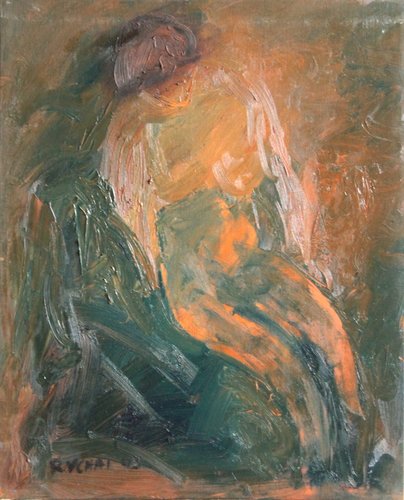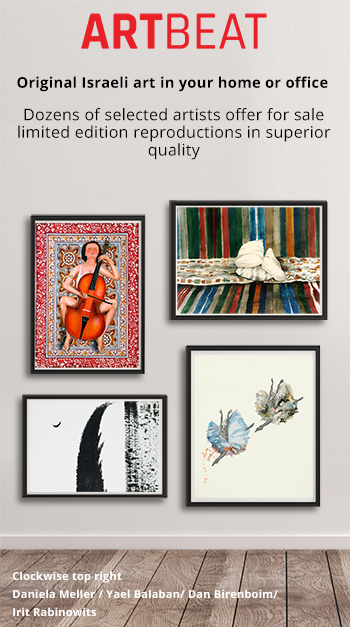Art Shows > Little retrospective
Little retrospective / Moshe aviv towers30/11/2018 to - 25/12/2018 Studies on the relationship between color and music have found that 95% of the type of color that people associate with a specific musical work can be predicted. Many times we hear about a picture that "sings" or about "dancing" colors, or "noisy" and "screaming" colors. And in our Jewish sources there is the well-known phrase "And all the people see the voices." In fact, the two artistic mediums share quite a lot in common, from the harmonious and tonal elements they share, to the various degrees of volume and rhythm, the sound games and the movement in space, which join together into a work of art. This strong connection between the languages ??- musical and visual - constitutes the philosophical and conceptual basis for the new and unique exhibition of the painter and musician Roger Yishai, which constitutes the essence of his artistic life for a period of 50 years. "The connection between music and painting stems from the unmediated and almost intuitive harmony between the eye and the ear, and its realization makes it possible to experience the 'musical painting' and the 'painterly music' with the gestures and intentions of the heart," says Roger Yishai. Roger Yishai, painter, musician and founder of the Artist Chai Ensemble, is an interdisciplinary artist with a unique language. His professional practice combines music, painting, poetry and teaching, and he attests that his professional life as well as his being are moving between them. His professional background in music and his depth in philosophy and philosophy give his work a depth and a reflexive dimension. Yishai, who lives and works in Jerusalem, deals with universal issues and traces the human image, while making a statement about contemporary society. The work of Roger Yishai ranges from abstract to figurative. He uses a mixed technique that combines texts and music from his poems as an inseparable part of the image, combining various materials, fabrics, jute, diapers and spices ... His reflexive works trace the existential situation, with human images and organs as head, Through which he seeks to deepen his investigation of the human body, and at the same time create a philosophical statement about humanity. Yishai also creates collages in a mixed technique that deal with contemporary culture and society, with reference to historical icons from politics, cinema and society. One of the central themes in his work is the motif of the mother. "Looking at my visual work and my writings, I try to define myself," says Roger Yishai. "I am a figurative painter - abstract, a little poet, a bit of an actor, a little musician, a bit curious ... but most of all I paint a character - my mother's image." Portraits are a work to enter, The symbolic walk of the colors creates a movement from the absolute imaginary black, through the dark, and finally to the ultimate imaginary white - the clarity, the absolute blackness, and the total clarity - the utopia, my approach in this symbolic walk is to give Life for the small moments of the hues, for the gradual transition from one color to the next I have not had any nostalgia, only a statement, an act, for my dead mother that I have not been able to express my dignity and my love for. It took me more than sixty years to understand my misunderstandings and injustice As an artist, over the years I have given up the desire to draw figurative characters of a faceless face, and I sketch only a sketch using a number of lines , And allows the viewer, the one who can see, the freedom to flood the inside of his soul, through shock Visual effect driven by my sketch. I bring up a face memory, a movement. I am looking for the future moment of the encounter in which the raising of the inner memory will reach the eye of the viewer. This dialogue between the viewer and the viewer gives freedom of interpretation. " Few artists in Israel and the world in general, who hold behind them so diverse artistic repertoire. Which combines over a period of more than a century, intense preoccupation with plastic art alongside a wide variety of styles and musical influences. Even the fascinating biography and the life-changing story of his life can be a source of inspiration for many. Yishai was born in the city of Oran, Algeria in 1941, and already had a wide variety of musical styles as well as extensive plastic arts. At the age of 16, he studied in Paris in the famous Scola Contour, and at the age of 18 he became a teacher at the academy. At the same time, he enrolled in the department of ethno-musicology at the prestigious Ecole des Hautes Etudes. After many solo performances in France, Germany, Hungary and Tunisia, Roger won a scholarship at the Budapest Academy where he studied Hungarian folklore, as well as Bartok and Kudai's methods. A long stay in Iran met him with Mizrahi music, which he continued to research and acquire at the Institute of Musicology in Paris, where he studied Iranian music with Jamsheed Shamiri and Chinese and Vietnamese music at Tran Wan Ka. At that time he founded the 'Roger Ishai Band' in Paris, which included four Iranian guitars and percussion instruments. For the band he wrote various works, as well as most of the arrangements, and with her appeared as a soloist in many places, including a concert at the Pompidou Center, around Jewish-Spanish music. In 1981, Roger Yishai immigrated to Israel and became a member of the Jerusalem Contemporary Music Ensemble and a teacher at the Jerusalem Music Center. He began to perform in many concerts (guitar solo), wrote arrangements for Ladino songs for Avraham Ferrera and recorded. In 2000 he founded the "Artist Chai" ensemble where he established a platform for workshops and concerts. Roger often performed on the concert stages as a soloist or ensembles (including performances at the Israel Festival and the Acco Festival). His rich repertoire includes works by Renaissance and Broke composers, contemporary music - Bartok, Villa Lobos and Israeli composers, Iranian music, Spanish-Jewish music (Ladino), and of course works of his own, and many transpositions and adaptations that are often heard on radio and television. Moshe Aviv Towers, 7 Jabotinsky Street, Ramat Gan. Closing The exhibition can be seen 24 hours a day. Translated using Google translate.location - Moshe aviv towers מגדלי משה אביב, רחוב ז'בוטינסקי 7 רמת גן- פתוח 24 שעות. Time - 30/11/2018 to - 25/12/2018 Exhibition opening - 30/11/2018, שעה - 12:30 |
|1|


